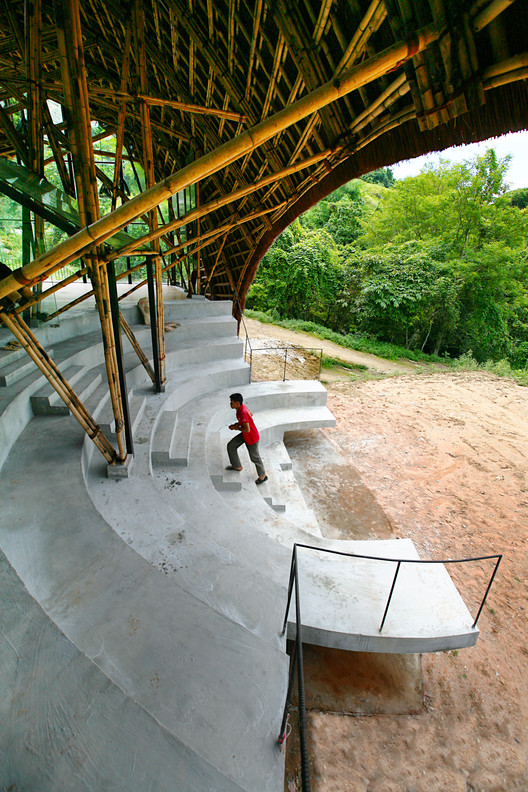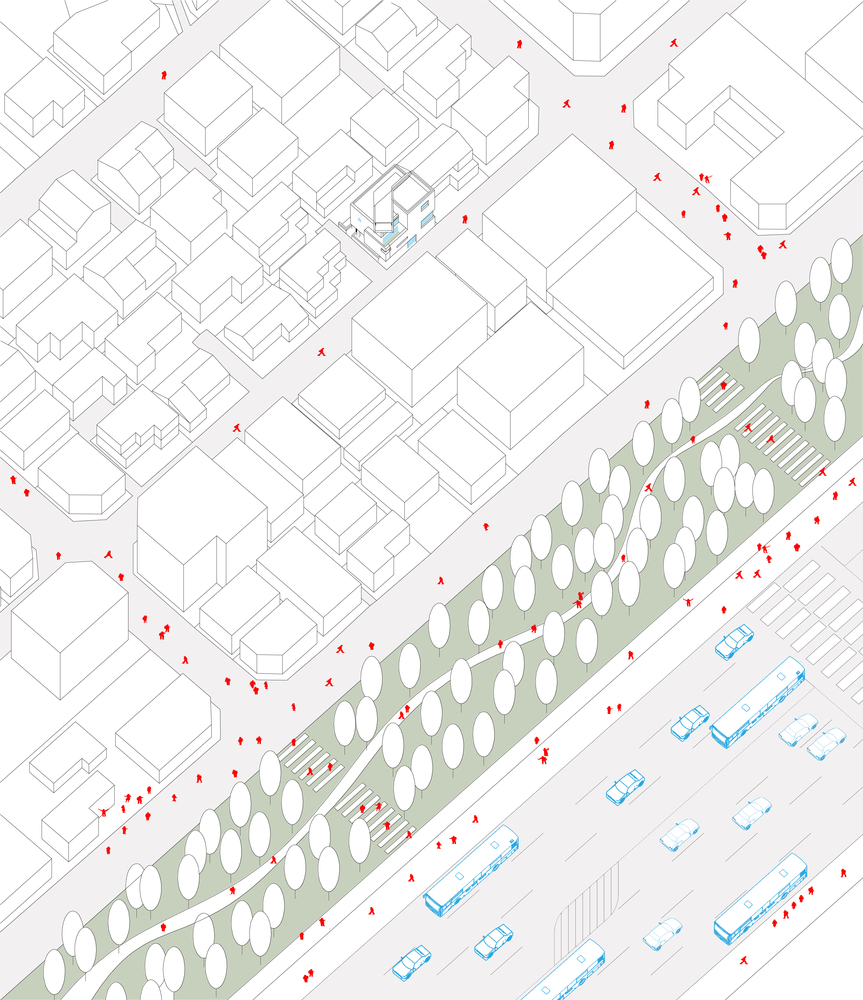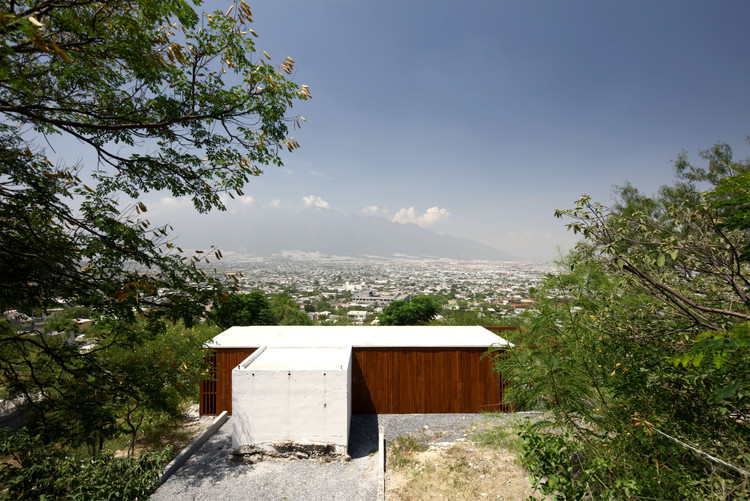Robatayaki Genroku - Kaiseki Shakuhachi Tsutsumi - Associates
2018-11-19 00:00
Facade. Image © Wei Liu
正面。形象(刘伟)


架构师提供的文本描述。该项目位于成都香格里拉大酒店一楼,有一个厨房,有两类,一种是日式烧烤Robatayaki,另一种是传统的日本菜Kaiseki。参照日本民居和武士茶室两种不同的传统类型,我们提取了特色元素,并对其进行了多层次的扩展,从而在不被消耗的情况下创造了一个持久的空间。
Text description provided by the architects. The project is located on the ground floor of Chengdu Shangri-La Hotel with a street frontage.There are two categories with a single kitchen,one is for the Japanese-style barbecue Robatayaki, the other is for Kaiseki which is a traditional Japanese meal brought in courses. Referring two different traditional typology of Japanese houses, civilian’s house and tea-room of Samurai, we extracted characteristic elements and expanded them multiple-layered, so to create an enduring space without being consumed.
Text description provided by the architects. The project is located on the ground floor of Chengdu Shangri-La Hotel with a street frontage.There are two categories with a single kitchen,one is for the Japanese-style barbecue Robatayaki, the other is for Kaiseki which is a traditional Japanese meal brought in courses. Referring two different traditional typology of Japanese houses, civilian’s house and tea-room of Samurai, we extracted characteristic elements and expanded them multiple-layered, so to create an enduring space without being consumed.
Robata day. Image © Wei Liu
罗巴塔日。形象(刘伟)


在关于平民血统的Robatayaki的部分中,我们提到了吉富的Yoshijima House,它有一个动态的木结构。首先,我们安装了一个老木框架在最高的高度,然后将镜子放在天花板上,以显示动态反射图像与双高度木结构。在面向街道的墙壁上,窗户和瓦石灯箱被设置成格子图案,这些定向灯优雅地举起了木架。
In the part for Robatayaki which is on the lineage of civilian, we referred to Yoshijima House in Gifu which has a dynamic wooden structure. First we installed an aged wooden frame in the utmost height, then put the mirror on the ceiling to show dynamic reflected image with double height wooden structure. On the wall facing the street, windows and washi light box are set in checkered pattern, and those directional light raise the wooden frame elegantly.
In the part for Robatayaki which is on the lineage of civilian, we referred to Yoshijima House in Gifu which has a dynamic wooden structure. First we installed an aged wooden frame in the utmost height, then put the mirror on the ceiling to show dynamic reflected image with double height wooden structure. On the wall facing the street, windows and washi light box are set in checkered pattern, and those directional light raise the wooden frame elegantly.
Robata night. Image © Wei Liu
罗巴塔之夜。形象(刘伟)


Robata night. Image © Wei Liu
罗巴塔之夜。形象(刘伟)


在关于茶室世系的凯泽基的部分,我们重叠倾斜的天花板,这是传统茶室的一种典型语言。这些天花板是由一个小的细百叶窗面板制作的,彼此有不同的角度,由这些层次感引起的云纹图案非常特别。私人房间也由Sunoko元素组成,墙后的上部灯光和天花板上的顶灯使小房间变得多样化。
In the part for Kaiseki which is on the lineage of tea-room, we overlapped tilted ceilings that is a typical language of traditional tea-room. These ceilings made by Sunoko which is a small fine louver panel has different angle each other, and the moire pattern caused by those layering directs extraordinary. The private rooms also consist of Sunoko elements, and upper light behind the wall and top light on the ceiling makes diversity in the tiny room.
In the part for Kaiseki which is on the lineage of tea-room, we overlapped tilted ceilings that is a typical language of traditional tea-room. These ceilings made by Sunoko which is a small fine louver panel has different angle each other, and the moire pattern caused by those layering directs extraordinary. The private rooms also consist of Sunoko elements, and upper light behind the wall and top light on the ceiling makes diversity in the tiny room.
Kaiseki counter. Image © Wei Liu
凯塞基计数器。形象六、伟刘


Kaiseki counter. Image © Wei Liu
凯塞基计数器。形象六、伟刘


Jornutzon曾经说过“日本建筑的特征是屋顶”,被设计成像屋顶一样。Robatayaki的定义应该被定义为茅草,但是由于火灾代码,它现在用稻草覆盖了泥味。Kaiski是由Fujimori发明的褶边铜板所覆盖,它看起来像传统的铜器由锤子完成。
The façade, as Jorn Utzon once said “the characteristic of Japanese architecture is the roofs”, is designed to be like roofs. That of Robatayaki should have been defined as thatch, but due to the fire code, it is now painted mud taste with rice straw. That of Kaiseki is covered with ruffled copper plates which was invented by Fujimori, it will look like a traditional copperware finished by hammers.
The façade, as Jorn Utzon once said “the characteristic of Japanese architecture is the roofs”, is designed to be like roofs. That of Robatayaki should have been defined as thatch, but due to the fire code, it is now painted mud taste with rice straw. That of Kaiseki is covered with ruffled copper plates which was invented by Fujimori, it will look like a traditional copperware finished by hammers.
Public corridor. Image © Wei Liu
公共走廊。形象(刘伟)


最重要的是,铜的老化是可以享受很长时间的,在消费社会里,商店内部的寿命往往很短,我们希望这个项目具有耐用性,因为它不会轻易消费。
Above all, the aging of the copper can be enjoyed for a long time, in the consumption society where the life span of shop interior will be often very short, we hope this project has durability as it won’t be easily consumed.
Above all, the aging of the copper can be enjoyed for a long time, in the consumption society where the life span of shop interior will be often very short, we hope this project has durability as it won’t be easily consumed.
Facade. Image © Wei Liu
正面。形象(刘伟)














































Interiors Designers Tsutsumi & Associates
Location 110 The Arcade at Shangri-La Center,9 Binjiang E Rd, HeJiangTing, Jinjiang Qu, Chengdu Shi, Sichuan, China
Interior Design Tsutsumi & Associates (Yoshimasa Tsutsumi, Weiwei Shi, Yu Peng)
Area 173.3 m2
Project Year 2018
Photographs Wei Liu
Category Interior Design
Manufacturers Loading...
























